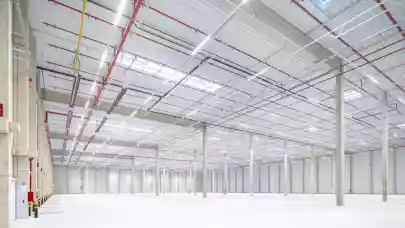
The performance of sectors relevant to the commercial real estate market improved in the second quarter of 2021, while the positive impact of growth on the real estate market fell short of that observed in previous cycles, partly due to the direct impact of the pandemic (lasting drop in tourism) and partly to uncertainties resulting from the trends accelerated by the pandemic (penetration of home office and e-commerce), the National Bank of Hungary (MNB) said in its latest Commercial Real Estate Market Report. In addition to an overview of the office, warehouse, hotel and retail markets, the report also reveals that the ratio of domestic investors in all property deals was nearly 80%, even higher than in the especially active year of 2019.
The market of commercial properties (offices, warehouses, hotels, and retail units including stores and shopping centres) has been supported by positive changes in several sectors and industries, and the strong performance of finance, manufacturing, retail and logistics, and ICT (information and communications technologies) has a positive effect on real estate segments as well. In 2021, the ICT sector merits special mention as its performance has doubled between 2010 and 2021.
Office and warehouse market in a nutshell
In the first half of 2021, the vacancy rate of the Budapest office market increased by 0.7 percentage points to 9.8%, and that of the industrial-logistics market by 2 pp to 4%. While higher office vacancy rate can be attributed to lower demand, in the industrial-logistics segment it was mainly caused by increased supply.
Vacancy rates in the retail segment stagnated as consumption picked up.
In the office and industrial/logistics markets, an increase in vacancy rates can be expected over the next one or two years, due to the high volume of new completions. However, these rates do not yet represent an excessive market risk, particularly in the latter segment.
No decline was observed in average rental rates in any of the segments, but looking ahead there may be a correction in rental rates for industrial-logistics properties. On the other hand, the expansion of supply also improves Hungary’s international competitiveness in logistics, which may become a stabilising factor for rental fees by fostering new demand.
Hotel market improves slowly, retail recovers quickly
Domestic hotel turnover improved as the waves of the pandemic subsided, but even in July of this year, the sector was still unable to reach the average monthly turnover level from 2019. The buoyant hotel development activity that commenced in recent years will boost supply by almost 3,000 new rooms over the next one and a half years, while certain analyses foresee international tourism returning to the pre-pandemic level by 2024.
In the first half of 2021, the development of retail sales was moderate compared to the growth in real earnings and the improvement in the consumer confidence indicator, which was offset on the consumption side by the pickup in services from the second quarter. The majority of retail store types were heavily exposed to the pandemic, but as the waves and the epidemiological measures taken subsided, turnover quickly recovered.
By the end of June and July 2021, most store types reached the average turnover of 2019.
In parallel with the gradual lifting of restrictions, the number of visitors to shopping centres increased significantly in the second quarter but was still well below 2019 levels.
Domestic investors dominate the Hungarian property market
In the first half of 2021, the investment turnover of domestic commercial properties rose by 15% in annual terms, reaching €0.6 billion.
A major part (58%) of this was generated by a few high-value transactions and 78% of it related to domestic investors.
There is still available liquidity and investor interest in the market, but buyers are cautious due to the lack of market price benchmarks and the prospects for individual segments. However, in parallel with the more moderate investment demand, the supply of properties for sale also declined, resulting in lower yields. Looking ahead, the monetary tightening cycle that has started in several countries may also reduce the yield premium offered by property investments.
HUF 270 billion in project loans under moratorium in hotel and retail segments
By the end of June 2021, credit institutions’ project loan portfolio secured by commercial real estate had expanded by 18% year on year. In the first half of 2021, credit institutions disbursed 22% more project loans secured by commercial real estate than in the same period of 2020. The forint ratio of the loan portfolio rose to an unprecedented 21%, with a major contribution from the central bank's FGS Go! scheme. During the first half-year, banks did not significantly change conditions on commercial real estate loans, while perceiving increased credit demand. According to the responses in the MNB's Lending Survey, institutions anticipate the easing of lending conditions in the second half of 2021. However, due to the industry-specific risks, caution remains a key consideration.
At the end of June 2021, the moratorium affected 46% of credit institutions’ project loan portfolios secured by commercial real estate. The ratio of loans participating in the moratorium was the highest, 80%, in the portfolio disbursed for hotel financing. The project loan portfolio under the moratorium connected to the hotel and retail segment amounts to HUF 270 billion, and the default risk is the highest here after the expiry of the moratorium. The capital adequacy of the banking sector is sufficient to deal with potential risks arising from the commercial real estate market.



